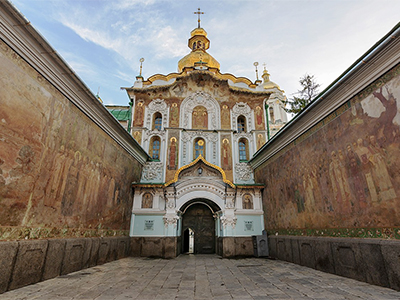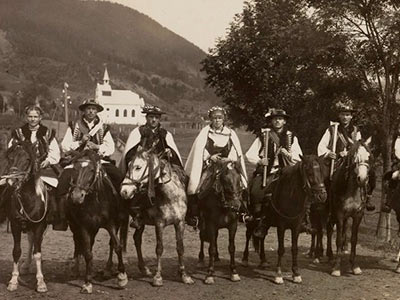 27.02.2024
World of pysanka
27.02.2024
World of pysankaUnraveling the Tradition of Pysanka
Pysanka (in Ukrainian the word “pysanka” is derived from the verb “pysaty”, that is «to write» or “to paint”) is an egg painted with bright colors in geometrical patterns or stylized figural, animal and floral designs. The tradition of painting chicken — or some other birds’— eggs is so old that no one would be able to tell when it started.
Christianity adopted this pagan tradition and Easter eggs have become an indelible feature of the feast commemorating the Resurrection of Christ.
Pagan Origins: The Symbolism of the Painted Egg
In many parts of the world one finds ancient myths in which the Egg features as a symbol of the Sun, Spring and Revival of Nature. Ethnologists of the 20th century have [discovered that the ancient beliefs of many peoples regarded the Egg of Light as a source from which the world had sprung, developing from Chaos to Order. In Ukraine the tradition of painting eggs goes back at least thirty-three hundred years — clay eggs, once evidently painted and dating from the 13th or 12th century B.C., were unearthed by archaeologists in the vicinity of the village of Pistynka at the Dnister River. Painted eggs must have been used as charms guarding against evil. There were pysankas of many kinds to fit many occasions. For it to have magic powers, a pysanka must be painted at a specified time, in certain colors and patterns and chants must be sung while it was being painted. It was also very important to give it as a present to the right person.
The Ritual of Pysanka Painting: Tradition and Beliefs
Pysankas were mostly painted elderly women, late at night, after everything had grown quiet. It was desirable to do it at the end of the day which had passed without any rows, scandals or emotional upheavals. It was a sort of a ritual in which one had to observe the rules whose origins had long been lost in the mists of time. One had to be very careful in preparing the paints and “pysachok”, that is a small wooden stick with a foil spiral on the end to be used for painting the egg. (Now, of course, paint brushes are used but you can’t create a “real” pysanka with a brush). The egg itself had to be either a fertilized one, taken from under a hen, or if the fertilization could not be ascertained the egg to be painted had to be sucked out. To do it one has to make two tiny holes with a needle at the opposite ends and then by a sucking it is possible to empty the egg of its contents. The symbolism of colors, patterns and designs varied from area to area but there were certain patterns and designs which were of a more universal character. It the colors, patterns, chanting and other things were right, if the eggs had been properly chosen and threated before being painted, if the time of the day when the painting was done was correct, then the painted eggs were believed to be powerful charms against fire, lightning, illness and other mishaps.
Aesthetic Pleasures and Hidden Meanings: Exploring Pysanka Patterns
Christianity imbued the painted egg with new meanings transforming it into the Easter egg and giving it a new symbolism but it could not eradicate the elements of pagan beliefs associated with the painted egg. Easter eggs, blessed in church by a priest, were continued to be used as a sort of charms for many different occasions: to be placed under the corner stone of a house; to help making bees to give more honey; to guard against misadventure on a journey; to secure happiness in marriage; to promote multiplication in the animal, flora and human worlds, to name but a few of its functions.
By the end of the 19th cent the art of painting eggs began to decline through Ukraine and unfortunately very few of the eggs dating from the 19th or earlier times have been preserved in private collections or in museums. Now, a certain revival of pysankas is observed. Hopefully it is part of the general revival of interest in the Ukrainian national traditions many of which go down into a very distant past.
Symbolism and Tradition: Interpreting Pysanka Designs
Looking at pysankas one can derive purely aesthetic pleasure from the colors and patterns. One can marvel at the skill and ingenuity of the artists (absolute majority of whom are, of course, amateurs) who have painted them. But it’s a much greater fun to know the hidden meaning of the combination of colors used, of patterns and designs. Some of the signs seem to be obvious but even the more obvious, like, say, all kinds of crosses, have meanings that go beyond their Christian significance.
❤️Experience painting an Easter egg on our tour while living with a real Hutsul family.
Controversies and Changes: Evolution of Pysanka Patterns
Rings painted on pysankas were believed to bring concord and conciliation into family life; representations of birds were painted on the light background (pink, light green and blue) if the pysanka was meant for children and on the dark background if it was to be given to grown-ups; «belts» were against unfaithfulness; floral patterns helped gain success. About a hundred patterns and designs were used and in the times of old it was strictly forbidden to change them to suit one’s artistic whims. But in our times new patterns and designs have begun to creep in. It is still a controversial issue. If one cannot change the words of an established prayer, can one change the patterns and designs that have long been established by tradition as the only acceptable ones.
Ancient Symbolism: Unveiling the Meaning Behind Pysanka Patterns
Some of the patterns and sighs on pysankas have symbolism that has come down to us probably from the pre-historic times. Wavy patterns symbolize rain; dots — grain which is about to sprout; squares and rhombi — earth and its fertility; the Greek cross — the Sun, and originally a god of the Earth; a zigzag with rounded angles — the snake which was a symbolical representation of a god of the Nether World; a tree — the sacred Tree of Life; a female figure — the Great Goddess, Goddess of the Sky, Protectress of all Life on Earth; a fish — health, fertility, life and death; birds — creatures that are able to fly high and thus carry messages to the gods; oak leaves — Perun, god of Thunder, of human and solar energy, of life, all the figural representations, of course, are highly stylized.
Pysanka in Ukrainian Culture: From Charms to Aesthetic Treasures
Pysankas and krashankas (eggs uniformly painted in one color, with no patterns or designs) used to be an important element in the Ukrainian country life. A lot of their symbolic meanings have been forgotten, they are not used as universal charms as much as they used to be. But they remain a joy to the eye and an exciting field for ethnographic studies. And for very many people pysankas, no doubt, have retained their special significance as an integral feature of Easter. Even those who do not care for pysankas pre-historic and Christian symbol is m ca n not help enjoying pysankas art.
-
 29.01.2024
Exploring the Treasures of Kyiv’s Lavra Monastery
In the heart of Kyiv lies the venerable Lavra Monastery, a testament...
29.01.2024
Exploring the Treasures of Kyiv’s Lavra Monastery
In the heart of Kyiv lies the venerable Lavra Monastery, a testament...
-
 13.01.2024
Kachanivka, Eden on Earth
Rich in history, it hosted renowned artists, notably poet Taras Shevchenko.
13.01.2024
Kachanivka, Eden on Earth
Rich in history, it hosted renowned artists, notably poet Taras Shevchenko.
-
 05.01.2024
Hutsuls: passionate and Freedom-Loving
Hutsul men used to carry weapons with them, pistols and axes on...
05.01.2024
Hutsuls: passionate and Freedom-Loving
Hutsul men used to carry weapons with them, pistols and axes on...

